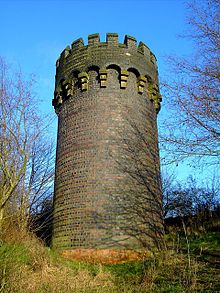Railway tunnels in and around Bristol are among more than 40 historic buildings and structures on the Great Western main line to be safeguarded by the Government.
Brunel’s iconic entrance to Box Tunnel in Wiltshire and the entry portals of the Chipping Sodbury tunnel near Badminton and its six ventilator shafts (pictured below) are joined on the protected list by less well-known parts of the railways such as the St Anne’s and Fox’s Wood tunnels in Bristol.
The pioneering 1.83-mile long Box Tunnel, perhaps the most famous on the GWR, has now been listed at Grade-II. Construction started in 1836 and when it opened in 1841 it was the longest railway tunnel in the world.
The battlemented tops of Chipping Sodbury tunnel’s ventilator shafts, which allowed the release of smoke and fumes from the two-and-a-half mile long tunnel, were the intended to look like follies, so reducing their visual impact on the nearby Badminton Estate.
Also safeguarded by the new list are both portals of Saltford Tunnel and the Severn Tunnel’s east portal along with a number of bridges around Bath.
In total 35 new listings and seven previously-listed structures along Brunel’s London Paddington to Bristol Temple Meads line – one of the most important railways in the world – are included in the upgrade by the Department for Culture Media and Sport.
Heritage minister John Penrose said: “Our railways and the historic buildings that go along with them are a wonderful and emotive part of our national heritage, symbolising for many of us a sense of romance, history and adventure. And nowhere more so, perhaps, than on the Great Western Railway. I am very pleased to be able to give these buildings, bridges and tunnels the extra protection that listing provides.”
Emily Gee, head of designation at English Heritage, which recommended the structures following extensive consultation with railway heritage and conservation groups, said: “This scale of consultation on designation cases is unusual for English Heritage and we were delighted with the thoughtful responses we received from railway history experts, local authorities and other heritage bodies. I am also impressed by Network Rail’s commitment to respecting the special structures in their care. We certainly hope to do more of this kind of partnership working with protection outcomes under our National Heritage Protection Plan”.
Network Rail route managing director Patrick Hallgate added: “The Great Western railway is undergoing the biggest investment since it was built in order to deliver faster and more reliable journeys for passengers. The results of the consultation carried out by English Heritage, and supported by Network Rail, provide an important step forward in modernising this historic rail route. It enables us to make informed decisions and, critically, protect sensitive structures whilst delivering major improvement work.”































